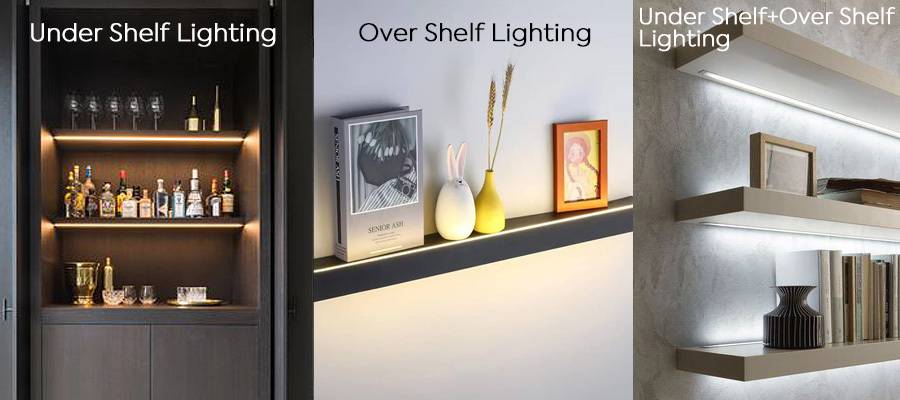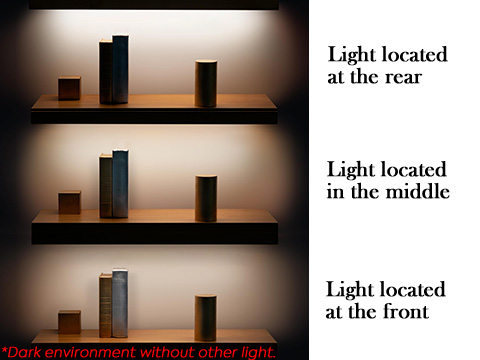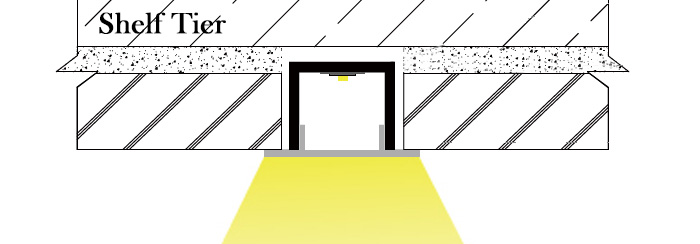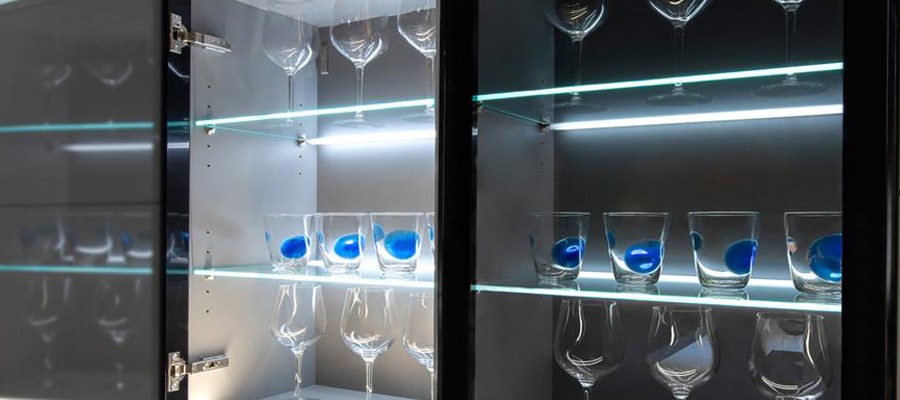There is an important need to design lighting on shelves. Many bookstores add light to their bookshelves to improve books’ visibility in order to make it easier for customers to select. Some display shelves do the same. Lighting makes shelving items easy to see/highlights items while providing an overall atmosphere that is either lazy or energizing.
You can update/remodel your shelf by adding lights to the top, the inside, and the sides. Where you add lighting to the shelving depends on your personal preference.
Shelf Types And Their Suitable Lighting
There are three different ways to add light to a shelf. Vertical-line light gives the entire shelf a three-dimensional look. Horizontal-line light focuses on illuminating the shelving items. Spot light highlights the contours and textures of a particular shelving item, also a lighting style commonly seen in artwork and museums.
Built-in lighting is the optimal choice when it comes to integrating shelf lighting into the overall design and presenting a more professional look. Lights embedded in shelves are suitable for all types such as bookshelves, floating shelves, display shelves, kitchen shelves, and so on. Additionally, the choice of under-shelf lighting or over-shelf lighting is also a clever way to differentiate.
Under Shelf Lighting vs Over Shelf Lighting
Under-shelf lighting has the light under shelf tiers and illuminates items from above. Since the light comes directly from above, there are relatively few shadows, and the items have an overall brighter and more even appearance.
Over-shelf lighting places the light on shelf levels and illuminates items from below. This creates a contrast between light and dark. This contrast makes the object stand out and the human eye will perceive more depth and dimension.
Using both under shelf lighting and over shelf lighting is a creative idea if you’re after a more balanced option.

Positioning of Lights on Shelves
It’s also worth noting that the placement of lights on shelf tiers is debatable. Different positions of the lights on the shelf level will have different effects on the overall shelf lighting effect.
When the LED is located at the rear of the shelf tier, the light will shine directly into the deepest part, creating a backlit effect.
Lights located in the middle of the shelf tier will produce an even illumination effect. Compared to rear lighting, center lighting reduces the shadow of the object, making it appear brighter and flatter.
When the light is located at the front of the shelf tier, the LED shines directly in front of the object, emphasizing the foreground features of the object. This type of shelving lighting brings out the details and textures of the object, and is suitable for occasions that emphasize the surface features of the display, such as a bookcase.

Display Shelves with Overhead Spotlighting
The use of overhead lighting on display shelves such as artwork is a unique lighting design. Overhead light helps to emphasize the three-dimensionality of the artwork and brings it to life in the light. Compared to side or bottom lighting, overhead lighting reduces reflections and glare, so viewers can see the true colors and details of the artwork more clearly.
Glass Shelves with Edge Lighting
The above methods apply to wooden shelves. For glass shelves, they have a special lighting design where the edges of the glass are lit with the help of channels or profiles. The transparency of the glass panel makes the shelf lighting more attractive.
Metal Shelves with Magnetic Lighting
The magnetic way gives a more suitable and easier way to install the lighting fixtures on metal shelves. The lights are firmly attached to the metal shelving by means of magnets.
This eliminates cumbersome installation steps and allows LED lighting fixtures to be quickly and easily installed or adjusted or removed without the use of additional tools.
Best LED Fixtures For Shelf Lighting
Whether extending your shelf lighting horizontally or vertically, LED strip lights are the best choice.
- LED light strips have excellent uniformity and provide consistent lighting throughout your shelves.
- LED light strips are all capable of ensuring an even distribution of light, preventing areas of low light or glare.
- LED light strips offer a high degree of customizability and can be cut and mounted as needed. This makes them suitable for a variety of different shapes and sizes of shelves.
- LED light strips offer a wide choice of colors and color temperatures, making the lighting effect of the shelves more personal. Whether it’s a warm yellow light or a crisp white light, LED strips are able to fulfill the needs of different occasions and atmospheres.
Light Strip vs Light Bar for Shelf Lighting
While both light strips and light bars can be different lengths, light bars are more oriented to focus on lighting a certain area of the shelf and the width of the light is generally wider and less customizable.
The flexibility, customizability, and varied color options of light strips make them a solution for designing unique and eye-catching shelf lighting.
Spotlight for Art Display Shelf Lighting
If the shelf has specific decorations, beautiful designs, or special exhibits (displaying artwork such as paintings and sculptures, or jewelry, models, collectibles, etc.), spotlights can be used to emphasize these details. Spotlight can focus the light on specific items with a concentrated beam of light, making them more prominent in the overall space.
Selection of LED Shelf Light Channels
LED channels lay LED strips inside the profile and are enclosed by a diffuser. By applying LED channels to your shelf lighting, you can hide the LED strips themselves and help make the shelf light distribution more even.
Shelf Light Recessed Channel
To embed LED strips in shelf tiers, you’ll need some recessed LED channels to assist. The use of recessed LED channel for led strip shelf lighting will give you a neat, seamless finished look as if the LED lighting was built into the shelf from the start.
It is fine to glue or screw the LED channels into the shelving recesses. Make sure that the screws used to secure the LED channel do not pierce the other side of the shelving.
We suggest choosing a recessed LED shelf channel with flanges, which will hide the recessed gaps. Usually, the recessed channel with flanges has two aluminum lines to finish the light path. We have a new line of this, they have the gaps coverage function but without the extra aluminum trim. It doesn’t add anything extra to the shelf other than the LED light.

If you care about light, there is also a category of built-in channels for shelves that are designed to be biased at roughly a 45-degree angle to purposefully illuminate the display area. Being built into the shelving, the light is directed back towards the inner shelf space and the eye is not looking directly at the LEDs at all, which helps to provide a more comfortable viewing experience.
Shelf Edge Lighting Channel
Shelf edge lighting has requirements for laminate/glass thickness on wood and glass shelves. If your shelf ply thickness matches, consider this type of shelf lighting.
The top and bottom illuminated edge lighting channel is ideal for backlighting. It produces an even, soft light that makes for a much better backlight than a single under shelf or over shelf light.
For bias lighting, there is a simpler way. Instead of cutting slots in the shelving, this specially designed shelf lighting channel is fixed directly to the surface, and the LED shines equally well into the shelf’s inner space.

Under Shelf Corner Lighting Channel
Corner lighting is a good option for shelves that are below eye level vision. It illuminates directly in the darkest part, so there is a relatively large range of light. The under-shelf corner channel comes with fixing clips and is easy to install.
Magnetic Metal Shelf Lighting Channel
By adding magnetic material (magnets) to the bottom of the magnetic lighting channel, it can be quickly and securely attached to a magnetically-absorbent metal shelf without the use of screws, glue, or other fixtures.
Choosing the Right Shelf Light Color
While it’s true that you can decide the color of your shelf lighting as much as you want, referring to the most compatible LED color for each shelf type is necessary, which makes you avoid some unbearable mistakes.
Wooden Shelves with Warm White Light
There’s a reason we usually say that wooden furniture works best with warm white light. When paired with wooden shelves, warm white light accentuates the natural warmth of the wood grain. Natural white light that can make the grain of wooden shelves look more defined is also fine.
Cool white light is less recommended for pairing with wooden shelves, as the color temperature may make the wood look colder. Colored lights can create a unique artistic effect on wooden shelves, but should be used with caution so that the colors are not too harsh. Ideal for creative, modern style decor.
Shelves that can be Matched to Any Light Color
White shelves, black shelves, metal shelves, and glass shelves are very versatile and can be matched with a variety of lighting colors. You can make your choice according to your preference.
How to Install LED Strip Shelf Lighting?
Customizing a shelf lighting takes a little effort. In order to keep the installation neat and beautiful, and to get it right the first time, it is important to take the time to route the shelves to make room for the LED strip lighting.
General Steps
First, determine where you want to add lights in shelves and calculate how long you need the strip light. Cut the LED strip based on the length you get from the measurements. Knowing the length of the strip lights will allow you to determine what size dimmer/controller and power supply you will need.
Power = Voltage * Amps
Amps = Power / Voltage
But actually, more power and amps are a good idea. Make sure that your power supply is not overloaded or running at maximum amperage all the time. This is something that must be circumvented with any power supply.
Actual Power Needed = Theoretical Power * 1.2
Or Actual Power Needed = Theoretical Power + Theoretical Power * 20%
The easiest way to power a DC led strip light is to use an adapter/desktop power supply that plugs directly into a standard wall outlet. Its power supply module converts the AC line voltage to DC voltage which LEDs need.
The second method is to connect the LED transformer’s input cord directly to 110V / 220V line voltage, which allows you to layout your shelf lighting without the constraints of outlet locations.
Precautions
Typically, our shelves have several tiers and each tier requires the installation of LED strip lights. Unless you have a separate power supply for each LED strip tier, you will need to electrically connect one section to the next. You can do this by soldering or some easy-to-use connectors to make the electrical connection between each section.
An important issue you need to be aware of during this process is the forward voltage drop. Due to the forward voltage drop, the maximum length of a low voltage DC LED strip running in series will be limited. Generally speaking, 12V led strip runs up to 5 meters (16.4ft) and 24V runs up to 10 meters (32.8ft). (The specifics depend on the type of strip.)
So the rest of the strip must be powered directly from the power supply, not from the previous strip. This is known as a parallel connection. An easier way to do this is to choose directly those light strips that do not have voltage drops.
